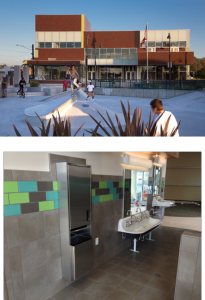
Crossville Tile Used for Youth Center in San Leandro, CA
With area school dropout rates rising and gang violence increasing, a group of youth in the Ashland community of San Leandro, Calif. began a quest to create a gathering place for themselves and their peers. The goal was to not only deter negative activity but to spark positive opportunities in a fun, safe place where young people could connect.
The initial, grassroots vision evolved into a full-scale project. The team at the heart of the endeavor took on the challenging intricacies of county government and nonprofit partnerships. Over the course of a decade, the community came together. With support of the county, arts commission, library, sheriff’s department and regional health care services, the project resulted in the Ashland Youth Center, a $13M, 31,500 square foot, iconic building that’s an epicenter of youth-centered services, activities and opportunities.
Crossville is honored to be part of this sustainably-designed, two-story facility that includes a library, public café, dance and fitness rooms, classrooms, a computer lab, visual arts room, childcare center, health clinic, career center, as well as administrative offices. Overall, the building design emphasizes transparency, openness and flexibility between the different functions to promote exploration, social connectivity and programming flexibility. Crosssville’s sustainably manufactured porcelain tile collections support the design sensibilities and performance requirements such a versatile space demands.
Ashland’s young people were as instrumental in designing the center as they were in working to have it built. From building layout, massing, detail development, color selection, logo development to selection of furniture and finishes, the youth were integrally involved in a participatory design process set up to ensure the center would appeal to its core audience. Emerging from the collaborative design process, the exterior tile surface design was commissioned by the Alameda County Arts Commission and offered a place for Crossville products to be used uniquely and prominently.
The building serves as an educational model for sustainable building, as it is expected to become the first Alameda County building to receive the coveted LEED Platinum designation from the U.S. Green Building Council. From top to bottom, the designers featured green elements including a vegetated green roof, integrated roof-top photo-voltaic panels, rain gardens, natural ventilation, extensive north-facing glazing for art and activity rooms, and south-facing building recesses and projections providing shade. To reach the LEED Platinum recognition, product selection was crucial, and choosing Crossville’s tiles for interior and exterior applications provided not only the aesthetic features but also the sustainable requirements in product manufacturing to support LEED.
The building’s prominent public art installation entitled Clearing envelopes the exterior walls withCrossville’s Wood Impressions as exterior cladding. It is a continuous porcelain tile surface in a modulating staccato of color and visual accents anchored by a two-tone color field. The artwork reinforces and amplifies the inherent rhythm of the building, using a subtle, visual slippage of physical geometries and a rising pulse of contrasting accent bands intensifying at the entrance. In addition to creating a work of art, the tiles are appropriate for seismic zone usage, graffiti resistance and are engineered for utility savings due to thermal mass advantages.
The interior restrooms were completed with Crossville’s Color Blox and Color By Numbers Collections. The color combinations feature the Cross-Sheen finish for easy maintenance and cleaning. Manufactured in the U.S., Color Blox contains a 4% pre-consumer recycled content and is Green Squared certified through the Tile Council of North America for its proven standards of sustainability.
Within the first week of the grand opening, more than 700 students registered as members at the center. Excited for the possibilities of the future, many of those young people who started the effort more than 10 years ago are now participating as recreation leaders at this state-of-the-art facility. From its grassroots origins and lasting design, the Ashland Youth Center is more than a great place to hang out; it’s a great place to grow up.
REACH Ashland Youth Center project team members:
Design Architect: RossDrulisCusenbery Architecture Inc.
Architect of Record: NTD Architecture
Design/Build Contractor: NTD Architecture
Public Art Exterior Surface Design: Collaboration Artist Amy Trachtenberg and Architect Mallory Scott Cusenbery
Tile Installer: Superior Tile
Tile Manufacturer: Crossville Inc.
Source: Crossville
[source: http://feeds.importantmedia.org/~r/IM-greenbuildingelements/~3/gt1VYRXKPDc/]

Leave a Reply
You must be logged in to post a comment.